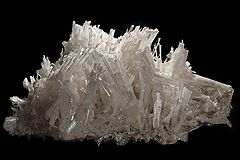Scolecite
| Scolecite | |
|---|---|

Scolecite specimen from India
|
|
| General | |
| Category | Silicate mineral |
|
Formula (repeating unit) |
CaAl2Si3O10·3H2O |
| Strunz classification | 9.GA.05 (10 ed) 8/J.21-60 (8 ed) |
| Dana classification | 77.1.5.5 |
| Crystal system | Monoclinic |
| Crystal class | Domatic (m) (same H-M symbol) |
| Space group | Cc |
| Identification | |
| Formula mass | 392.34 g/mol |
| Color | Colorless white, pink, salmon, red or green |
| Crystal habit | Thin prismatic needles, radiating groups and fibrous masses |
| Twinning | Common on {100}, twin axis [001], rare on {001} and {110} |
| Cleavage | Perfect on {110} and {110} |
| Fracture | Irregular/uneven |
| Tenacity | Brittle |
| Mohs scale hardness | 5 to 5½ |
| Luster | Vitreous, silky when fibrous |
| Streak | White |
| Diaphaneity | Transparent to translucent |
| Specific gravity | 2.16 to 2.40 |
| Optical properties | Biaxial (-) |
| Refractive index | Nx = 1.507 to 1.513 Ny = 1.516 to 1.520 Nz = 1.517 to 1.521 |
| Pleochroism | X: colourless Y: colourless Z: colourless |
| Solubility | Soluble in common acids. |
| Other characteristics | Pyroelectric and piezoelectric, sometimes fluorescent yellow to brown in LW and SW UV. Not radioactive. |
| References | |
Scolecite is a tectosilicate mineral belonging to the zeolite group; it is a hydrated calcium silicate, CaAl2Si3O10·3H2O. Only minor amounts of sodium and traces of potassium substitute for calcium. There is an absence of barium, strontium, iron and magnesium. Scolecite is isostructural (having the same structure) with the sodium-calcium zeolite mesolite and the sodium zeolite natrolite, but it does not form a continuous chemical series with either of them. It was described in 1813, and named from the Greek word, σκώληξ (sko-lecks) = "worm" because of its reaction to the blowpipe flame.
It is monoclinic m with space group Cc, but crystals are pseudotetragonal. Scolecite, like natrolite and mesolite, usually occurs as acicular (needle-like) and fibrous aggregations. It has nearly the same angles between the crystal faces as does natrolite, but natrolite is orthorhombic and scolecite is monoclinic. The etched figures (figures that arise from the action of a solvent on a crystal face, and indicate its true symmetry) and the pyroelectric character of scolecite show that it crystallizes with a plane of symmetry, but no axis of symmetry, that is to say it belongs to the hemihedral class of the monoclinic system. Scolecite can therefore be distinguished from natrolite by an optical examination, since the acicular crystals do not extinguish parallel to their length between crossed nicol prisms. Twinning on the ortho-pinacoid is usually evident.
...
Wikipedia
